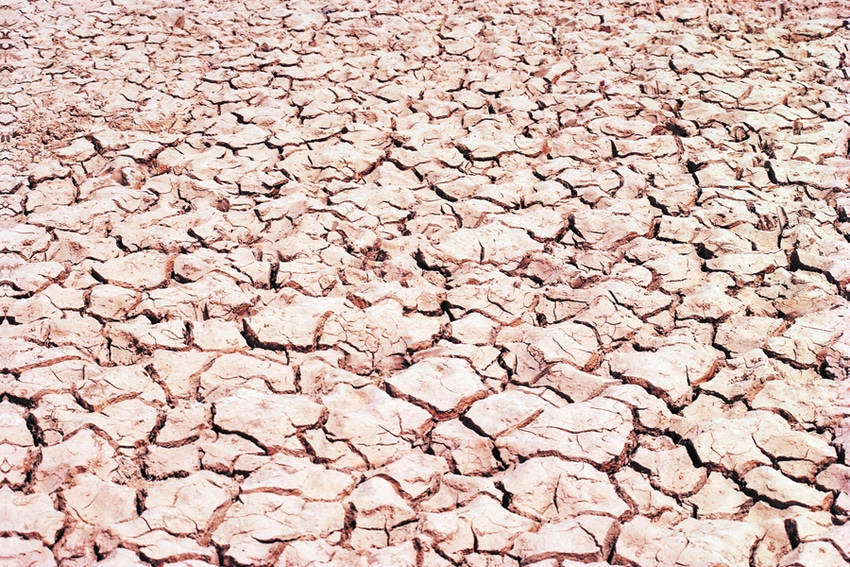
There's very little hope left for the dryland cotton crop in west Texas, but the irrigated crop is in desperate need of a significant rainfall as well.Some areas of the High Plains have received less than an inch of rain since July of last year.Producers can’t irrigate fast enough in the dry conditions. Evapotransporation rates are at all time highs.

With rain neither falling nor forecast in Texas, many cotton producers are seeing their hopes of selling $1.20 cotton literally dry up in the dust.
“I don��’t think people realize how bad it is,” said Brad Heffington, Littlefield, Texas, producer and president of Plains Cotton Growers, Inc., speaking during the Ag Market Network’s June conference call.
Heffington, who farms in the High Plains, said, “No one alive that I know has seen the level of drought we’re seeing in west Texas right now. It breaks records set back in 1895, when they started keeping records.”
Since July 3, 2010, Heffington says, his farm has received 0.6 inch of moisture from two rains. “We got 0.4 inch last October and 0.2 inch in May of this year that was gone by lunch the way the winds were blowing.”
Heffington says there’s very little hope left for the dryland crop, “but I don’t think people realize how serious the situation is on the irrigated crop, especially on the High Plains. We have limited irrigation that is typically supplemental to the 18 inches of rain we usually receive annually. Without any rain in the last year, I don’t want to sound like I’m ringing the bell, but it’s serious, as serious as I’ve ever seen it.”
Producers can’t irrigate fast enough in the dry conditions,” according to Heffington. “Without some significant rain in the next few weeks, even irrigated production is going to be way off.”
Heffington believes that the 1 million bale reduction in USDA’s estimate of U.S. production “won’t come anywhere close to what the final number will be. Looking at the numbers from yesterday’s report, if you take another 2 million bales off the Texas crop, that’s a 15 million bale U.S. crop. That would drop ending stocks to 700,000 bales. I don’t know how that’s going to equate to the world.”
Heavy irrigation is starting to take a toll on water supplies in Texas as well, Heffington said. “We’ve been pumping water for the last two months trying to get this crop going. The longer farmers are running, the bigger the cones of depression are getting, and wells are dropping. Just in my area, we’ve heard of five house wells going dry. When you start losing house water, it’s getting serious.
“We really don’t know what to do. You can’t confer with any of the older generations. The closest thing to it they’ve seen are the crop conditions in 1956. And there’s nothing in the forecast that gives a producer much hope. It’s just not very pretty right now. It usually does rain some out here. But this year, we’re just not getting any.”
Heffington adds that very few drip-irrigated cotton fields are up either, “because of difficulty getting water to the surface to germinate the seed. Those are our highest production fields and there is hardly any of that up. It won’t come up without rain.”
Record evapotransporation
The combination of heat and wind is producing record evapotransporation (ET) rates, according to Heffington. “There were two days when we set a record for an ET rate of 0.68, and the next day it was 0.52 . So in two days, we had evapotransporation rates of 1.25 inches. It takes seven days for producers to send a pivot around to put out 1.25 inches, and it was sucking it out in two days. That’s why we can’t get a crop germinated. We can’t keep up with the evaporation rate.”
On speculation that Texas producers may collect their insurance payment for a failed crop and plant wildcat cotton, Heffington noted, “They’re not going to spend $70 an acre to plant seed on dry dirt that they couldn’t get cotton up on the first time.”
Carl Anderson, Extension professor emeritus, Texas A&M University, believes USDA’s June 30 acreage report will project about 6.1 million acres planted in Texas. “But it will be meaningless. We’re going to lose so many acres where cotton will not even germinate. The big question is how much can you get out of irrigated acreage, which traditionally averages about two bales an acre.”
Heffington says many producers on irrigated ground he’s talked to expect to make 50 percent to 65 percent of their average yields. “Nobody is talking about being in the 1 ton club. Many would be happy to make a bale under a circle.”
Heffington says forecasts call for a possible rain in the High Plains for around June 20, “then after that, we don’t expect any rain events until the fall if moisture comes up from a hurricane. Some forecasters think we may be in the midst of a two-year drought and we may not have significant rainfall until a year from now. It’s made everybody very nervous.”
The drought has turned optimism over prices into despair over the lack of rain, according to Heffington. “A lot of producers took (Allenberg Cotton Co., CEO) Joe Nicosia’s advice a few months ago when he said to plant every acre you can to cotton. Every acre that was fallow was planted by producers looking at $1.20 cotton. Everybody went into this crop thinking we’d get a rain in May, that even half-bale cotton would be better than nothing. We were willing to invest the money expanding acres. But it doesn’t mean anything when nothing comes up. We just can’t beat this heat.”
About the Author(s)
You May Also Like





